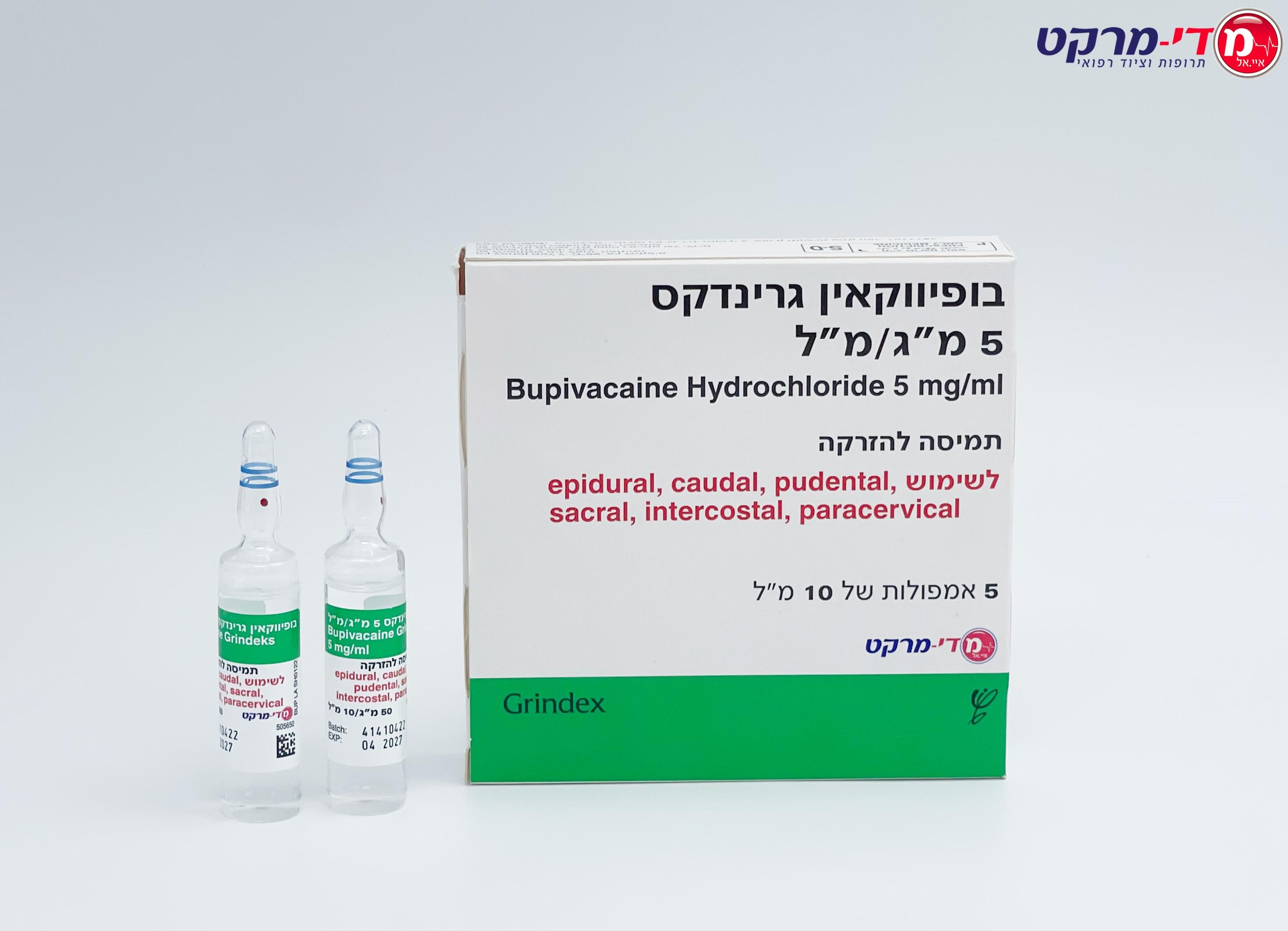Quest for the right Drug

בופיווקאין גרינדקס 5 מ"ג/מ"ל BUPIVACAINE GRINDEKS 5 MG/ML (BUPIVACAINE HYDROCHLORIDE)
תרופה במרשם
תרופה בסל
נרקוטיקה
ציטוטוקסיקה
צורת מתן:
זריקה באזור צוואר הרחם, לעצבי הצלעות, לאגן, לתוך עצב, לתוך הזנבעצם הזנב, אפידורל : PARACERVICAL, INTERCOSTAL, SACRAL, PUDENTAL, CAUDAL, EPIDURAL
צורת מינון:
תמיסה להזרקה : SOLUTION FOR INJECTION
עלון לרופא
מינוניםPosology התוויות
Indications תופעות לוואי
Adverse reactions התוויות נגד
Contraindications אינטראקציות
Interactions מינון יתר
Overdose הריון/הנקה
Pregnancy & Lactation אוכלוסיות מיוחדות
Special populations תכונות פרמקולוגיות
Pharmacological properties מידע רוקחי
Pharmaceutical particulars אזהרת שימוש
Special Warning עלון לרופא
Physicians Leaflet
Special Warning : אזהרת שימוש
4.4 Special warnings and precautions for use Procedures using regional or local anaesthetic procedures should always be performed in the vicinity of resuscitation equipment unless the procedure is very minor. An intravenous cannula should be inserted prior to large blocks, before the injection of local anaesthetic. Reports have been received of cardiac arrest or death following the use of bupivacaine in epidural anaesthesia or peripheral nerve block. In some cases, resuscitation has been difficult or impossible despite appropriate treatment. Extensive peripheral nerve blocks can involve the administration of large volumes of local anaesthetics to highly vascularised areas, often the vicinity of large blood vessels. In these cases, there is an increased risk of intravascular injection and/or systemic absorption, which can lead to high plasma concentrations. Like all local anaesthetic agents, bupivacaine may cause acute toxic effects on the central nervous system and cardiovascular system if use results in high blood concentrations. This applies particularly after inadvertent intravascular administration or administration into highly vascularised areas. Some regional anaesthesia techniques may be associated with severe adverse effects, as indicated below: • Epidural anaesthesia can cause cardiovascular depression, particularly in cases of concomitant hypovolaemia. Therefore, caution should be exercised in patients with impaired cardiovascular function. • In rare cases, retrobulbar injections may reach the cranial subarachnoid space and cause e.g. temporary blindness, cardiovascular collapse, apnoea and convulsions. These symptoms must be treated immediately. • Retrobulbar and peribulbar injections of local anaesthetic are associated with a certain risk of persistent ocular muscle dysfunction. The primary causes are traumatic nerve injuries and/or local toxic effects on muscles and/or nerves due to injected local anaesthetic. The extent of this tissue damage depends on the degree of trauma, concentration of the local anaesthetic and the duration of exposure to the local anaesthetic. For this reason, the lowest possible effective dose should be used. Inadvertent intravascular injections in the head and neck area can cause cerebral symptoms even at low doses. • Paracervical block can sometimes cause bradycardia or tachycardia in the foetus; and the foetal heart rhythm must be closely monitored. Caution should be obsered in patients with AV block II or III, as local anaesthetic may decrease myocardium transmittance. Particular attention should also be paid to the elderly and patients with severe hepatic disease or severe renal impairement, patients in the late stage of pregnancy or with poor general health . Patients being treated with class III antiarrhythmic agents (e.g. amiodarone) should be closely monitored and ECG monitoring should be considered since the cardiac effects of bupivacaine and class III antiarrhythmic agents may be additive. Hepatic dysfunction, with reversible increases in aspartate aminotransferase (ASAT), alanine aminotransferase (ALAT), alkaline phosphatase (ALP), and bilirubin, have been observed in rare cases following repeated bupivacaine injections or bupivacaine infusions of long duration. Immediate discontinuation of bupivacaine has led to rapid clinical improvement. If signs of hepatic dysfunction are observed during administration of bupivacaine, the medicinal product must be discontinued immediately. (See section 4.8). Epidural anaesthesia may lead to hypotension and bradycardia. The risk of such effects can be reduced, e.g., by injecting a vasopressor. Hypotension should be treated immediately with administration of an intravenous sympathomimetic and repeated if required. There have been post-marketing reports of chondrolysis in patients receiving continuous postoperative intra-articular infusions of local anaesthetics. The majority of reported cases concerned chondrolysis in the shoulder joint. It has not been possible to establish a causal link due to several contributing factors as well inconsistencies in the scientific literature with regard to the mechanism of action. Intra-articular continuous infusion is not an approved indication for Bupivacaine Grindeks 5 mg/ml. Paediatric population The safety and efficacy of Bupivacaine Grindeks 5 mg/ml in children younger than 1 year have not been established. Only limited data are available. The use of bupivacaine for intra-articular block in children aged 1 to 12 years has not been documented. The use of bupivacaine for major nerve block in children aged 1 to 12 years has not been documented. For epidural anaesthesia, children should be administered gradually increasing doses proportional to their age and weight, Since epidural anaesthesia at the thoracic level in particular can result in severe hypotonia and impaired respiration. This medicinal product contains 31.48 mg sodium per ampoule (10 ml), equivalent to 1.57 % of the WHO recommended maximum daily intake of 2 g sodium for an adult.
Effects on Driving
4.7 Effects on ability to drive and use machines Depending on the dose and method of administration, bupivacaine may have a transient effect on mobility and coordination.

שימוש לפי פנקס קופ''ח כללית 1994
לא צוין
תאריך הכללה מקורי בסל
לא צוין
הגבלות
לא צוין
מידע נוסף
עלון מידע לרופא
13.03.22 - עלון לרופאעלון מידע לצרכן
לתרופה במאגר משרד הבריאות
בופיווקאין גרינדקס 5 מ"ג/מ"ל